Water meters are for the measurement of utility services. Meters one inch or smaller are furnished and installed by the Water Department.
How your water meter is read.
In the first week of each month, our Water Department begins to read the water meters throughout the Town’s Water District. This usually occurs at night when traffic conditions are at a minimal. All of the Town of Schererville water meters have the remote read option. This means a signal with your meter reading, for that particular month, is transmitted to the water department van that drives down each and every street in the water district. The read is then downloaded through 2 water computers located in the van. After the routes are complete, the water meter reads are transferred to the water billing system inside the Schererville Town Hall.
Water Meters inside homes and businesses.
The Town of Schererville has various types of meters to accurately measure the use of water in your home or business.
The following pictures are the types and styles of meters used throughout the Town’s Water System.
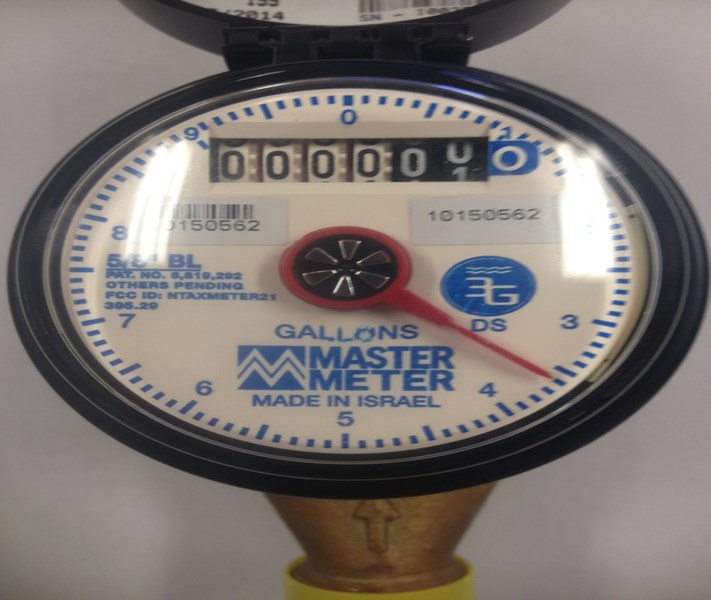
Complete ¾” Master Meter –We only read the left 4 numbers of the odometer. The silver, star shaped, round dial in the middle of the red arm is called the leak detector dial. This dial should not be moving when no water is being used. If it is moving when no water is being used then there is a leak inside the property. One complete revolution of the red needle indicates that 10 gallons have been used.
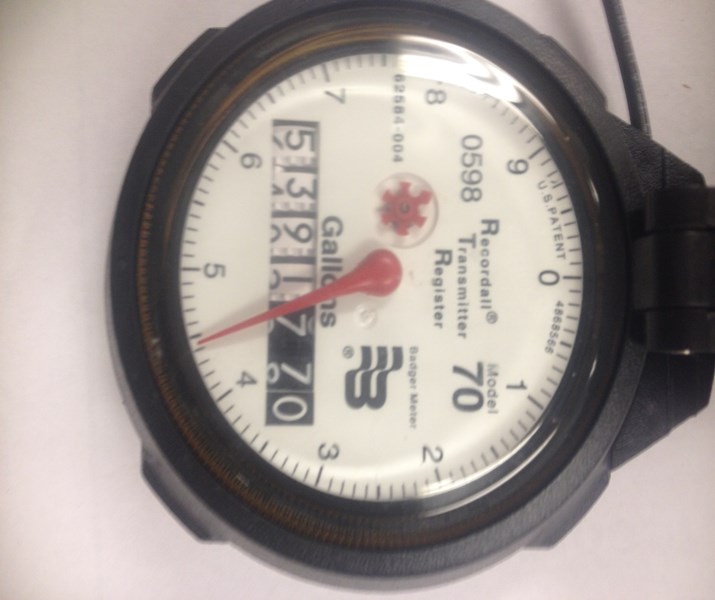
The Badger/Trace system- Some houses in the Schererville Water system are equipped with a Badger meter and the Trace reading system. The Trace system has a wire coming off the head of the meter that runs to a square box called a TP box. The TP box then transmits the reading out to our water department van. We are currently changing these units out of homes and businesses as the batteries in the TP boxes begin to fail. The reading on this meter would be 5,391,000 gallons. The small, red, star shaped dial is the leak detector dial.
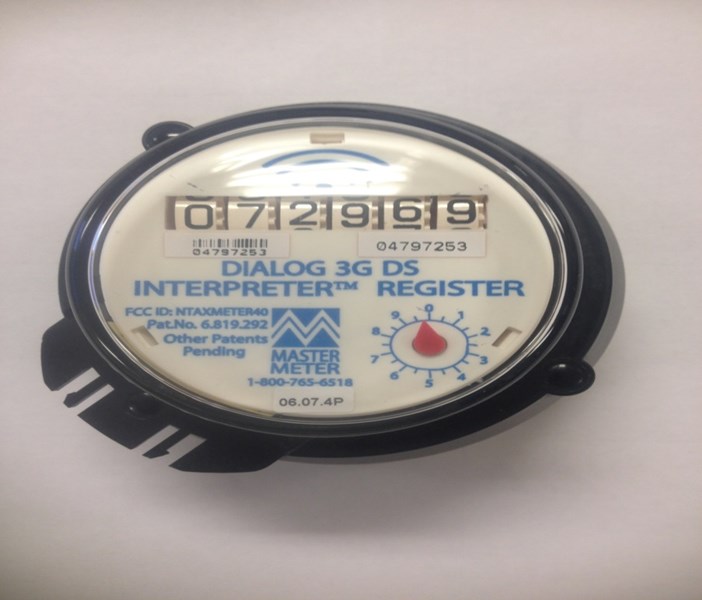
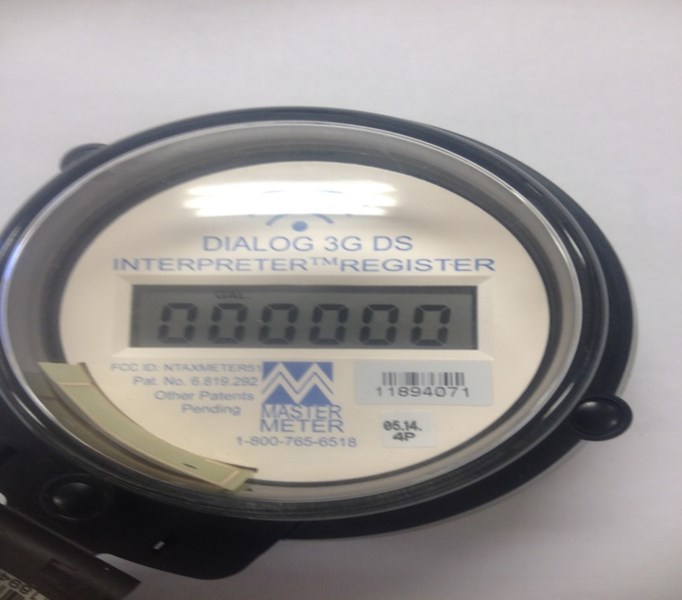
The above 2 images depict our Master Meter Interpreter Register meter replacement heads. These heads can be programmed to fit any size meters from house sized meters to industrial size meters. When these heads are programmed, the computer program adds however many set 0’s are needed for a particular measuring chamber.
The odometer style head (top picture) has a small red dial and every full revolution constitutes either 10 gallons, 100 gallons, or 1,000 gallons, depending on the meter size it is attached to. The reading for this meter if it was placed on a ¾” meter would be 729,690 gallons. The digital style head (lower picture) is also a replacement meter head. These heads flash with the rate of flow and the actual reading on the meter. The computer program is also set to however many 0’s for the chamber it would be installed on.
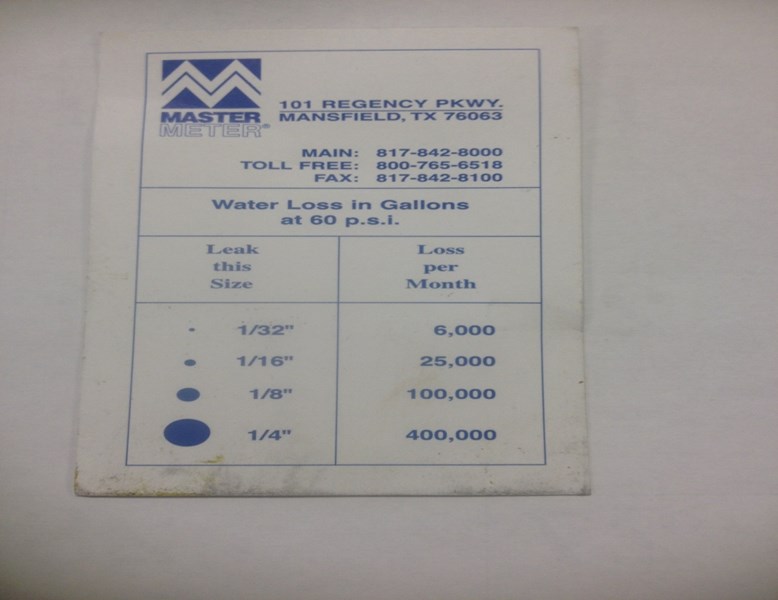
Slow Drip
Slow drips of water can add up quickly. For example, a toilet that “keeps running” after you flush it or a sink that drips after it is turned off, can waste thousands of gallons of water a year. If the drip is hot water, you are paying for wasted energy as well. Fix leaks as soon as you find them.
A “Running” Toilet Leak
One of the most costly household wastes of water is a leaky toilet. According to the American Water Works Association, toilets account for 45% of all indoor water use in a typical residence.
Toilet leaks can range from small to large, constant to random, or from being heard or silent. They all cause wasted water. Depending on the water pressure to your house, a running toilet can leak 1 gallon of water per minute which adds up to 1,440 gallons per day.
Fortunately, most toilet leaks are relatively easy to fix. In a properly functioning toilet, no water should move from the tank to the bowl, unless the toilet is being flushed. A leaking toilet loses water from the tank to the bowl without being flushed. A toilet can also waste water due to an improperly adjusted or broken fill (ballcock) valve causing water to enter the tank and flow into the overflow tube.
1. Most toilet leaks are caused by a faulty valve (also known as “flush valve ball” or “tank flapper”). Most hardware, plumbing and home improvement stores supply flappers. How to check for a leaky toilet flush valve (flapper): Carefully remove and set aside the tank lid. (Don’t worry. This water is clean until it enters the bowl.) Add some food coloring or a dye tablet to turn the water a different color. Put the tank lid back on. Wait 15 minutes and do not flush. If dye appears in the toilet bowl, the flapper valve in your toilet is leaking and should be replaced.
2. The second most-common type of toilet leak is caused by an improperly adjusted or broken fill (ball cock) valve. This type of leak can be seen simply by taking the tank top off and observing if water is flowing into the overflow tube once the tank is full.
A Leaking Faucet
A leaking faucet is frequently the result of a bad rubber washer. The washer on a sink is typically located under the handle. A washer is relatively easy to replace with the right tools. It does require shutting off the water under the sink, and removing the handle.
- A leaky faucet that drips at the rate of one drip per second can use more than 3,000 gallons per year.
- A showerhead leaking at 10 drips per minute can use more than 500 gallons of water per year.
Leaky Automatic (in-ground) Irrigation Systems and Spigots
An irrigation system should be checked each spring before use to make sure it was not damaged by frost or freezing. An irrigation system with pressure set at 60 pounds per square inch that has a leak 1/32nd of an inch in diameter (about the thickness of a dime) can waste about 6,300 gallons of water per month!
Check your garden hose for leaks at its connection to the spigot. If it leaks while you run your hose, replace the nylon or rubber hose washer and ensure a tight connection to the spigot using pipe tape and a wrench